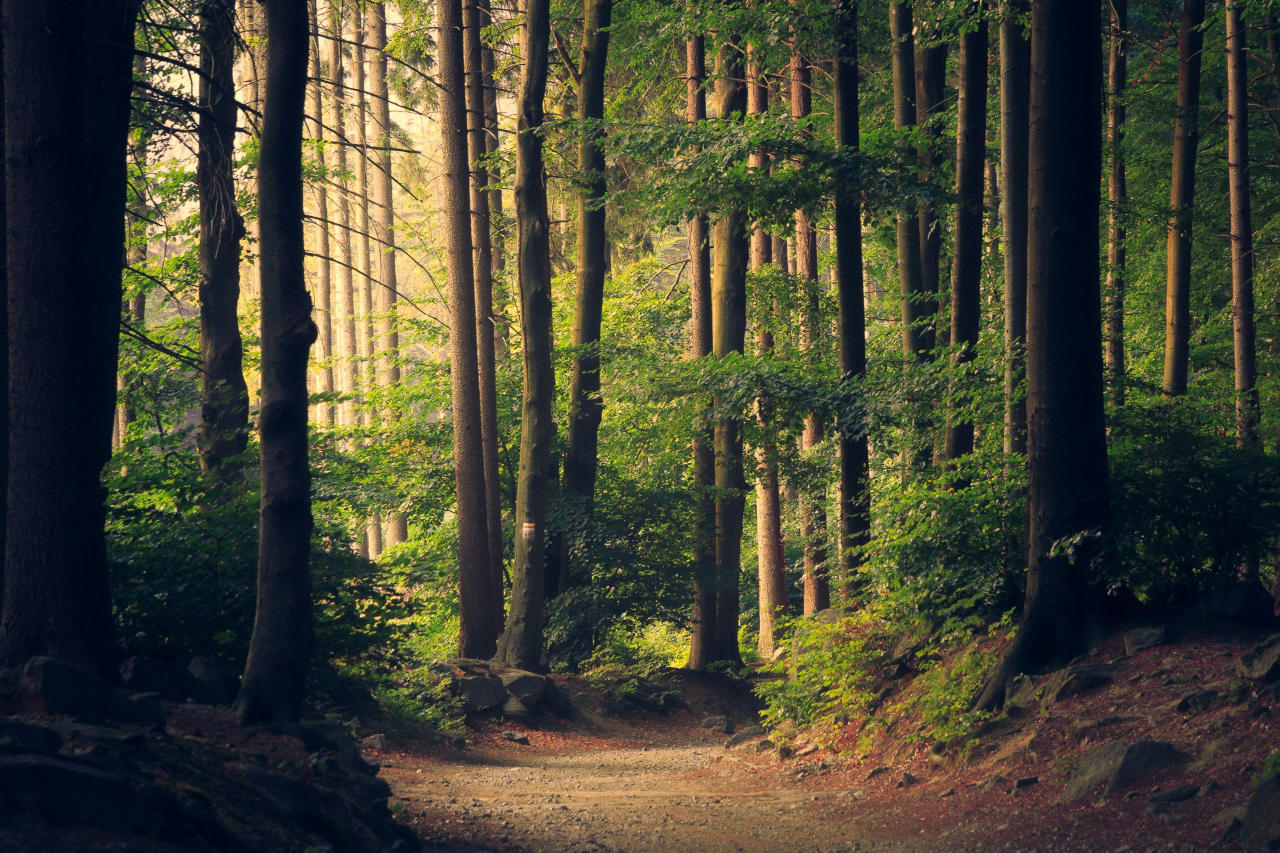Most of us recognise some value in time spent in nature. We might not think too much about it, but we know that some plants in the house look nice, and a walk in the park or woods is more peaceful than the city streets.
Yet, time in nature offers us more than we might realise. Some benefits are obvious but others much less so. Both body and mind are refreshed, strengthened, and inspired by nature.
People living within a mile of green spaces show a lower rate of 15 diseases, including diabetes, asthma, and heart disease.
When it comes to ADHD and nature therapy, a 2004 study found that children with ADHD had a greater reduction in symptoms after spending time in green outdoor settings. In fact, a couple of studies suggest that time in nature might reduce the risk of developing ADHD.
What makes nature so effective at giving us a mental and physical boost?
A paper from 2015 identified 21 possible pathways through which nature can nurture our mental and physical health, from chemicals in the air, to a lack of pollutants, and the sensory pleasure we get from simply looking at green spaces and listening to the soothing sounds.
Let’s explore some of the interesting theories and findings behind nature’s power.
Attention Restoration Theory
Psychologists Stephen and Rachel Kaplan studied the effects of nature and formulated the attention restoration theory—claiming that time spent in nature restores our ability to concentrate through ‘effortless attention’.
We all know modern city environments are ample with distractions, flashing lights and sounds, and it takes mental effort to ignore it all when you need to keep your mind on a task.
After prolonged reliance on this form of willpower, we get tired, grow fatigued, and become less able to maintain attention or make good decisions—the effects of this can closely resemble the symptoms of ADHD, although they are temporary.
While taking a break from busy urban settings, nature gives us an environment that attracts attention but does so gently, more often leading to a state of wonder and fascination, and giving the brain a chance to recharge.
The Kaplans found a short dose of nature therapy (50 minutes) can lead to significant cognitive gains, including attention and memory.
These benefits are mostly found in the right prefrontal cortex (PFC), which has been linked to controlled attention, as well as to the fatigue experienced after sustained attention.
For those with ADHD, the PFC has also been shown to be smaller and less active in children, and there’s an asymmetry in the blood flow between the left and right hemispheres.
The PFC is clearly key to maintaining attention, and this highlights the important relationship between ADHD and nature, with the restorative power of green spaces helping make up for the difficulties faced by the PFC.
Daydreaming
Stephen and Rachel Kaplan noted what we’ve all likely grasped intuitively—nature captures attention without cognitive effort, it’s soothing and enjoyable. The rustling of leaves, chirping of birds, or gentle movement of water can engage our senses without overwhelming them.
This form of effortless attention or soft fascination gives us give us perfect chance to let our minds wander.
Mind wandering or daydreaming often gets a bad rap, ridiculed as one of the distractions that stand in the way of focused attention—and in situations where we need to perform a task or solve certain problems, it is indeed a hindrance.
However, we daydream so prevalently that there must be a reason for it, it’s an evolutionary adaptation, a feature rather than a bug. And some researchers suggest we look for a ‘middle way,’ to cultivating it more effectively.
For one thing, daydreaming is a massive boon to creativity and imagination. In many ways, imagination itself is a form of daydreaming, a detachment from the present world around us, into a realm where time and space are unhinged and all sorts of alternative universes can effervesce.
As the anecdote suggests, we often have our best ideas in the shower, when the mind is free to roam, and most creative people know that sometimes the best solutions come when you deliberately stop thinking about solving the problem.
Things happen in the background when the mind is gently engaged with something else—taking a shower, washing the dishes, or wandering in the woods.
Another thing that happens as the mind wanders is the strengthening and consolidation of memories. While sleep is where this process happens most prevalently—just think about how forgetful and groggy you get from a lack of sleep—it turns out something similar happens when we daydream.
At the same time that those creative sparks are working their magic in the background, so too are your neural networks reinforcing your recent experiences and discoveries.
These two activities might even be one and the same, perhaps when the selective fortification of memories in the background strikes upon novel connections, they flash upon your mind as a helpful insight.
Physical Exercise
At this point, everyone should be clear that some form of regular exercise is beneficial to our health—it’s more like a necessity.
Even a light walk can help get your blood pumping, giving your cardiovascular system a boost. If you go on a more strenuous hike, you’ll get a full-body workout with both cardio and strength work.
Taxing your lungs and muscles can reduce anxiety, stress, depression, and inflammation, and it does so via numerous different pathways.
It can also help settle your mind into a nice balanced state. The moderately active body nudges the mind into a higher gear by pushing blood and oxygen through the neural machinery.
This middle way is perfect for the creative form of daydreaming, and also for flow states—It leaves you more alert than if you were sedentary and relaxing, but less active than when you are stressing out over tasks and problems or engaged in an intense physical workout.
There is also a significant relationship between ADHD and exercise, having been shown to boost attention in those with ADHD by up to 30%, with cardio proving the most effective form—exactly what you’ll get with a good walk out amongst the trees.
Chemical Reactions
Plants and soil release an array of different chemicals and compounds—you can probably smell a lot of them when you go wandering through the woods, especially if you run into a patch of onions or garlic.
As it turns out, some of these can contribute to our health and well-being.
For instance, phytoncides are organic compounds given off by plants. They were discovered in 1928 by the Russian biochemist Boris Tokin, and help our bodies produce natural killer cells, giving our immune system a nice boost.
Something else you’ll find if you go wandering in the woods is an abundance of ‘negative air ions.’ These molecules have a negative electrical charge and are created in numerous (natural) places: under the UV light of the sun, where lightning strikes, from certain plant growth, and where water collides with itself.
Some research suggests these negative ions have a range of health benefits, including a reduction of depression and stress, better regulation of sleep patterns, a boost in immune function, and an increase in metabolism.
Consider all the dust, bacteria, and other ‘particulate matter’ that floats around modern indoor environments, getting into your lungs and body—a lot of it is probably a little harmful. Negative air ions help to reduce this airborne debris, letting you breathe easier.
Beyond the plants and air, a little sun is also highly beneficial. While you need to be careful to protect your skin from too much sunlight, the resulting vitamin D helps keep your bones strong and your brain in a good mood. Unfortunately, many people suffer from a deficiency.
All the more reasons to engage in nature therapy.
3 Ways To Connect With Nature Outdoors:
Gardening
Growing your own plants, either indoors or outdoors, has a range of health benefits.
Rachel Kaplan, when exploring Attention Restoration Theory, suggested that gardening is quite capable of offering the restorative power needed.
Tending to plants can be quite a meditative activity, giving your mind something ‘softly fascinating’ to do, which provides perfect circumstances for letting the mind wander.
In addition, a number of other studies have shown that indoor plants can do everything from enhance job satisfaction, to reduce stress, improve your mood, and boost mental health.
Shinrin-Yoku
A Japanese concept which roughly translates as ‘forest bathing’. To do it, you simply go for a walk in the woods, with no goal to get anywhere, just to focus on the senses while you wander and admire the scenery.
The concept was coined by Tomohide Akiyama in 1982, and in subsequent years the Japanese government put a lot of money into researching the benefits and creating a large collection of dedicated forest therapy trails.
Some research shows that forest bathing helps reduce stress, hostility, and depression, while increasing liveliness. A recent meta-analysis suggests that forest bathing can help reduce many mental health symptoms, particularly anxiety.
In the physiological sphere, one study reports that “forest environments promote lower concentrations of cortisol, lower pulse rate, lower blood pressure, greater parasympathetic nerve activity, and lower sympathetic nerve activity than do city environments.”
Hiking or Trekking
Unlike shinrin-yoku, there is a goal of getting somewhere when you go hiking. It can take you through forests and jungles, over mountains and to the bottom of valleys, across snowy fields and rocky plains.
It’s also often a longer trip, from a few hours to several days or more. It’s more strenuous than forest bathing, you’ll get more of the benefits of physical exercise and exhaustion, and it can be a full-body workout too.
Beyond the physical, hiking and trekking longer distances can present a challenge for the mind—you need the willpower and motivation to fight through fatigue, a practice that can help strengthen your resolve in other situations.
It doesn’t end there, long treks can also work wonders on your creativity—a study of backpackers found a 4-Day hike led to a 50 per cent increase in creativity.
Get Your Nature Therapy Outdoors
Most of our evolutionary history has been spent outdoors, in the elements, exposed to a wealth of other living and non-living organisms.
Granted, we were often at risk from some of these elements and organisms, so we invented technologies to protect us in ways our ancestors would be simply awestruck by.
We can live in warm and dry homes, with a variety of foods from around the world, a screen to absorb all the world’s knowledge from, a medicine cabinet stocked with healing potions and a hospital not far away for the more pressing issues.
But the comfort that has enveloped many of us can backfire. Neither extreme is good—you don’t need to go and live in the wild without any modern luxuries, but spending too much time ‘safely’ indoors has its own host of problems.
We need nature, we benefit from inhaling the fresh clean air, the sun on our skin, the beauty of the scenery. Both our bodies and minds were built for it.
Try it for yourself and see—compare a day spent inside with one spent wandering through the woods, see which one truly empowers and enlivens your mind.
- 10 Tips, Tricks And Tools To Overcome ADHD Paralysis - March 19, 2025
- 10 Interesting Facts About Adult ADHD And Mental Health - March 18, 2025
- 15 Ways To Manage ADHD Without Meds By Biohacking Dopamine - February 14, 2025




